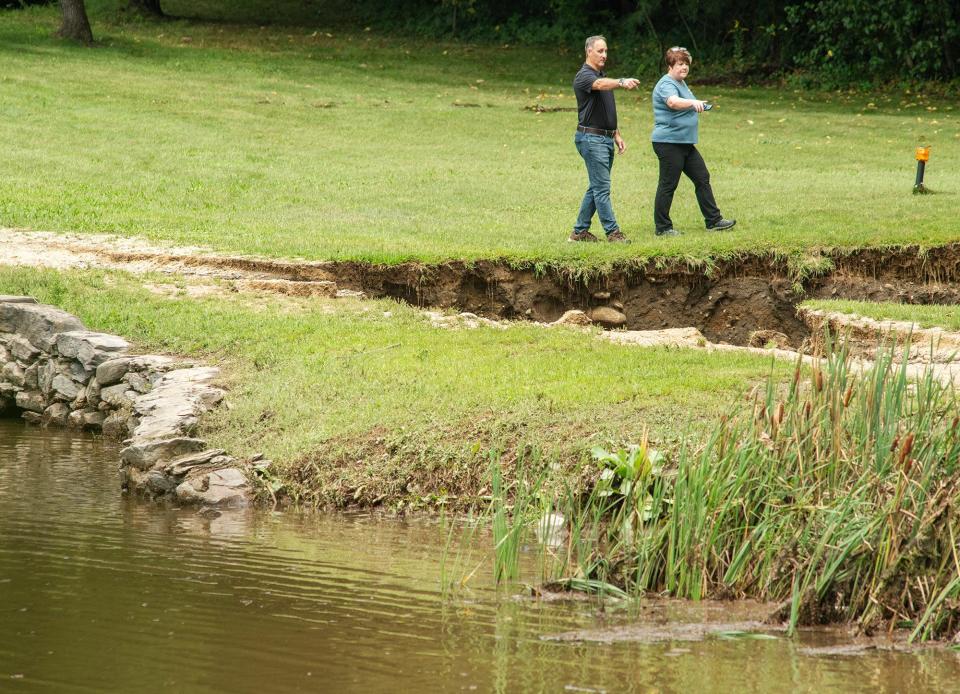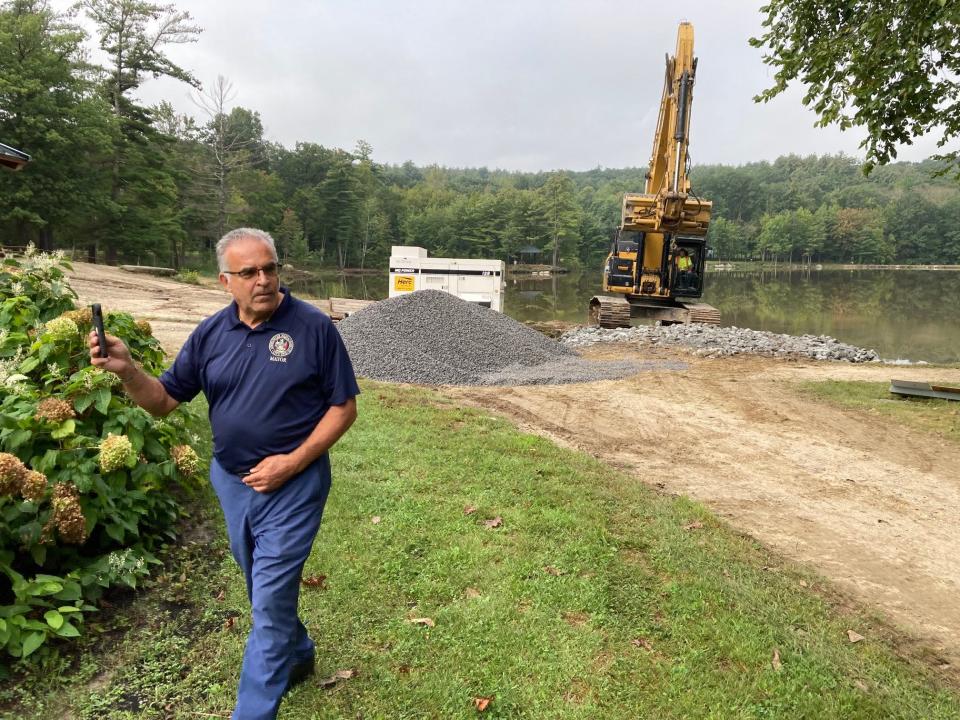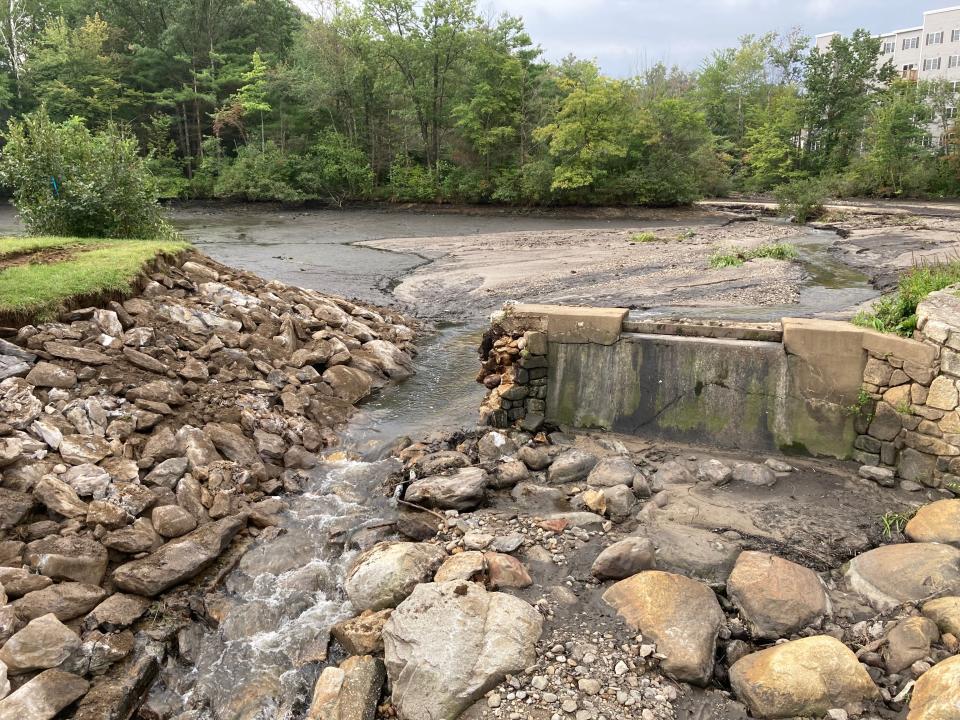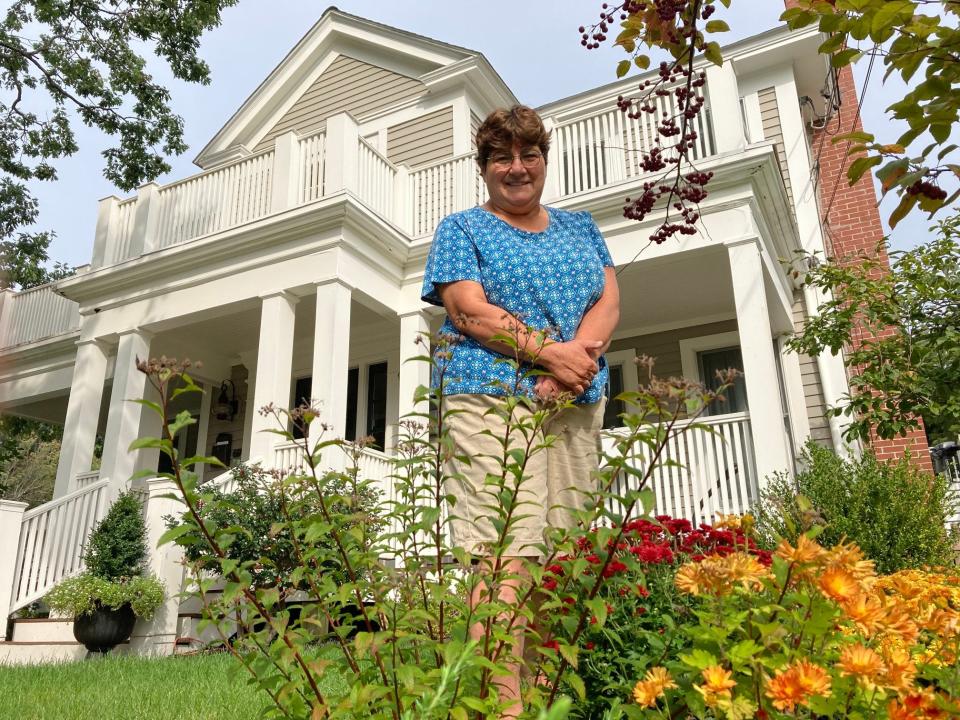'Wakeup call': Leominster floods show risks posed by deficient dams in Mass.
Brooks Pond Dam in Leominster. Filling a gaping hole with boulders due to Monday’s flooding. @telegramdotcom pic.twitter.com/0Vzg2ubfxG
— henry.schwan@telegram.com (@henrytelegram) September 13, 2023
LEOMINSTER — As Mayor Dean Mazzarella surveyed the damage at Barrett Park Pond Dam caused by torrential downpours on Monday, he said it’s a “wakeup call” when it comes to dam safety in Leominster and across Massachusetts.
That state of affairs, as Mazzarella sees it, came as he gazed upon a giant hole at the Barrett Park dam caused by 9.5 inches of rain that overwhelmed Leominster and left the city scrambling to repair roads, homes and other dams.
“(The damage) is worse than I thought,” said Mazzarella, on the scene Wednesday morning as crews worked to stabilize the Barrett dam. "This is a wakeup call for everybody. ... We’ve got to take this more seriously.”
Taking it seriously means two things: making sure the state’s thousands of dams are structurally sound; and, ensuring that the safety of homes and businesses downstream from the structures is covered.
A breach could result in loss of life and significant property damage when massive amounts of water held in lakes, ponds and rivers can suddenly become a roaring wave of destruction if a dam fails.

"Complicated situation"
A “complicated situation” is what Mazzarella called the state's hodgepodge of dam ownership. Some are owned by cities and towns, others are privately owned, and some are dormant for years. This mix muddies the waters when it comes to who is responsible for repairs, and when they will happen.
More: Massachusetts dam safety inspection database
Dams are also in a varied state of physical shape, with some in good condition, while others are crumbling or neglected.
There are roughly 3,000 dams statewide and many are not ready for current and future storms, said the Charles River Watershed Association. It’s time to remove dams that are lying dormant, said the association, in order to protect residents from “catastrophic” flooding.
Meanwhile, the state Office of Dam Safety doesn’t have an up-to-date public database that includes all dams in Massachusetts, including their current hazard classification and condition. The Office of Dam Safety did not provide an official who could speak about the commonwealth’s dams and their current level of safety.
Leominster: One scene of challenges
Leominster is an example of the complicated dam landscape in Massachusetts.
State records show five city-owned dams classified as “high hazard." That means the potential for loss of life and property damage is high if a dam fails. Leominster owns four of these dams, and one is privately held.
The city also has eight “significant hazard” dams, meaning the potential for loss of life and property damage if a dam fails is significant. Leominster owns all but two of these dams. The others are in private hands. Contributing to confusion are dams in Leominster owned by the city or in private control without a hazard designation, according to state records.

Barrett Park Pond Dam is one of Leominster’s significant hazard dams, and residents living downstream were evacuated during Monday night’s storm. The dam is now deemed safe by the Massachusetts Emergency Management Agency, said Mazzarella.
The last time the dam was inspected occurred in November 2021, and it was found to be in poor condition, according to the state. In that same year, Leominster received a $165,500 state grant to upgrade the dam. Design and permitting is done, and the city is seeking state and federal funds to pay for construction costs for a permanent fix.
Never seen a storm like Monday's
Raymond Racine had a busy Wednesday from his office command center at the Leominster Department of Public Works. With 42 years of DPW experience, Racine said he’s never seen a storm of Monday’s magnitude. More rain fell Wednesday, even as Racine stressed that the city’s hired engineer believes all dams owned by Leominster don't pose an immediate risk.
“We’ve completed miracles in two days,” said Racine, who acknowledged that when it comes to the mixture of dam ownership in Massachusetts and the wide disparity in conditions, something must be done to fix the challenge.
“All of our [city-owned] dams in Leominster have been replaced” over the past 25 years, except for Barrett Park Pond Dam, said Racine. “As for state dams and private ones, I don’t know.”
As Racine sees it, money is the driving force when it comes to dam safety and integrity. There’s just not enough cash from local, state and federal sources to pay for all the fixes that need to happen.
“I don’t see money for private [dam] funding,” said Racine. “[State and federal governments] have to catch up on municipal and state-owned dams.”

Private dams take a hit
Brooks Pond Dam, a private dam in Leominster, was damaged in Monday’s storm. A big chunk washed away, leaving the pond’s muddy bottom visible as Nikki Parker looked on as an excavator worked to fix the damage.
Parker's mother lives in an apartment close to the dam, and Parker said she was “very scared” when the storm hit Monday. She didn’t know if she could evacuate her mother if waters rose to a dangerous level.
“Holy cow. I’ve never seen a pond this empty,” said Parker, as she and friend Tami Devoe watched the excavator dump large boulders to plug up the dam’s wide opening. “This is a real eye-opener.”
Parker believes climate change is a motivator for the state and local communities to focus on dam repair and safety, because more storms – and intense ones – are on the way due to the warming of the planet.
“This summer we had crazy storms, and more are on the way. I’m nervous,” said Parker. “This opens the door for everyone to see the problem. We all have to come together to do something about this and hold [officials] accountable.”
How safe are dams in Worcester?
Worcester prioritizes dams that need inspections and repairs over ones that don't require immediate attention. Getting the cash to pay for the work is always a challenge, said Jay Fink, Worcester’s commissioner of public works and parks. But he believes the 32 dams that Worcester owns are “overall in pretty good shape.”
Roughly a third of the 32 dams are located in Holden, Leister and Paxon because reservoirs in those communities are sources of Worcester’s drinking water. Private dams within city limits – city officials didn’t immediately have the exact number – fall under the state’s regulatory authority.
Worcester’s dams are inspected monthly, said Fink, in addition to the state’s inspection requirements that are based on a dam’s hazard classification.
“Where there are causes for concern,” said Fink, are private dams that may not match the level of inspections for Worcester-owned dams.
Three dams are on Worcester’s priority list for repairs: Patch Pond Dam and Quinsigamond Pond Dam – both fall within city limits - and Poor Farm Pond Dam in Shrewsbury. Sediment buildup and trees growing in and around the Patch and Quinsigamond dams must be removed, because they're issues that could impact structural integrity.
Meanwhile, the dam in Shrewsbury, a holdover before town border lines changed, has spillway issues, and Fink said the goal is to remove it.
Managing dams: State process is layered
The state's Department of Conservation and Recreation and Office of Dam Safety have a long list of dam regulations.
● Regulated dams – those with hazard potential classified as high, significant and low – require inspections by a dam engineer hired by the dam’s owner. Smaller dams – those under six feet in height or with a storage capacity at maximum water storage elevation of 15 acre-feet or less – are not regulated by the state. Neither are dams owned by or regulated by the federal government, plus dams used for agricultural purposes.
● Inspection frequency is set by the state: every two years for high hazard potential; every five years for significant hazard potential; and every 10 years for low hazard potential.
● Owners of high and significant hazard dams must hire a dam engineer to prepare and submit an emergency action plan to state and local officials to be used in cases of dam failure or emergency. It's up to each community to decide if it wants to use the plan in an emergency. The plans include inundation maps that show where breached waters are likely to flood a community.
Currently, the state Office of Dam Safety does not have a map showing all areas that could be affected by flooding caused by a dam failure.
The Charles River Watershed Association cited steps the state should take to alleviate concerns about dam safety: Update dam hazard ratings using rainfall projections that account for climate and property risk; update maps to show where flooding would happen if a dam failed; and make both sets of information publicly available.
Plus, set a priority to remove dams that have outlived their useful lives, and invest in river restoration. Taking those steps makes more sense compared to costly dam repairs or disaster recovery, said the association.

"Pretty lucky"
Sue Little is feeling “pretty lucky.” She’s lived in her Chestnut Street home for 42 years next to Barrett Park in Leominster. When the dam breached on Monday night, Little’s basement flooded, an inconvenience that she said could have been much worse.
Little’s home is on high ground, so she feels safe, but she’s worried about those living downstream from dams, especially as climate change presents a threat.
"I don’t feel confident about the safety of those who live downstream. We’re not taking climate change seriously, and we need to,” said Little. “More and more dams are failing, and little dams like Barrett Pond can cause a lot of damage.”
Several miles away, as the mechanical arm from an excavator dropped boulders to shore up the damaged Brooks Pond Dam, onlookers conveyed a range of opinions about dam safety in Massachusetts.
"This was a freak of weather,” said Chet Carlton. “There are no guarantees when you get 10 inches of rain. I feel good about dam safety."
“It’s a sign of the times when it comes to weather patterns changing," said Freddy Basantes as he watched the excavator in action. "Every year storms are becoming a little more severe. I couldn't tell you if dams across Massachusetts are safe, but I have confidence the state will handle it the best way they can."
Contact Henry Schwan at henry.schwan@telegram.com. Follow him on X: @henrytelegram.
This article originally appeared on Telegram & Gazette: Leominster flooding shines light on Mass. dam safety problems

